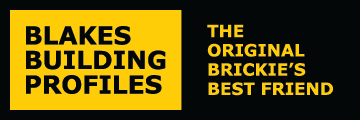History

What was life like in 1967? How many things have changed? In 1967 petrol cost 14 pence per litre, Harold Wilson was Prime Minister and we had just won the Eurovision song contest with Sandie Shaw and Puppet on a string. The first Automated Teller Machine in England was installed in Enfield Town Centre and George Blake had finally perfected the first workable Building Profile. George was a Master Builder and was well aware of the benefits of raising brickwork without having to raise corners first. In those days, a bricklayer was proud of his ability to raise a perfect corner.
Many attempts had been made in the past to introduce a reusable metal profile to replace the various timber versions which each bricklayer made for his own use. George Blake realised that a successful profile needed to consist of a simple straight mast set up clear of the brickwork, and yet close enough to allow bricks to be “laid to the line”. The profile should be easily plumbed to vertical at the same time set to a positive horizontal datum to precisely control the level of the brickwork and key building points such as window sills. The profile had to be able to take a line holder which slid easily up and down, and the profile must not mask the brickwork to allow rubbing in of joints.

George realised that the attachment of the profile to the corner was the key to solving the problem. His first trial designs were made of heavy gauge steel, had the same 4 setting screws that the modern Blakes Building Profiles use, and used the perps at 1.1/2 brick and 1 or 2 bricks as the attachment point. George used this product to test the concept and by 1967 the Profile had evolved into virtually the same profile as is sold by Blakes Building Profiles today.
George Blake believed absolutely in the benefit of using his Profile, and promoted them in Colleges, Trade Shows and even abroad. He knew then that the time saved by using his Building Profile would mean that they would pay for themselves in only 2 weeks work. In 1967 a pair of External Profiles was £18.00 and a pair of Intermediate Profiles was £12.00. To put this in context the average price of a house in 1967 was £4000 (£180,000 today)
From 1967 to 1986, having patented the product, Blakes Building Profiles were distributed to 1000s of customers world wide. When the patent ran out several copycat Profiles were launched, few survive today having to adopt subtle changes in design which detract from the purity of the original design. In the early 1990s during the building slump when work was short, Blakes continued to supply those bricklayers who realised that in good times the Blakes Building Profile makes you money, by the time saved, and in lean times allows you to work more competitively.




Blakes Building Profiles are still a privately owned company and still in Berkshire, not far from where it all started. 3 years ago a survey of users was completed to see if the product could be updated or improved. Most users were outraged at the idea of changes to “Blakies”. The only criticisms were: “The hollow mast can fill up with muck over time making them very heavy”, and “We can’t get the pencil marks off the zinc coated tubes”. As a result the only changes made were purely cosmetic. Blakes Building Profiles are now powder coated in a Portland Grey colour in order that a non-permanent marker pen can be used and plastic caps are fitted to the top and bottom – not many designs can claim to be so right first time.
As Blakes Building Profiles were used worldwide, bricklayers with their own ideas approached Blakes. One such man was Matt Parkman who invented the Blockdolly. Working with Blakes the Blockdolly design evolved and was launched 7 years ago. Blockdolly extended the use of an Externally mounted profile to allow lines to cover Internal blockwork. Both lines are set from the same point which ensures cavity width from damp proof course to Wallplate.

Blakes launched Laurens Ladder last month, invented once again by a working bricklayer – Mick Gapper. Blakes believe that it will become the preferred method of laying soldier courses in the future, both for the time saved and by ensuring consistent alignment regardless of skill level. Once again Blakes face the challenge of getting a good bricklayer to try a new method of laying bricks when they already know they can lay a soldier course using a line and boat level – but they cant do it as quick!
So what has changed in the 40 years since Blakes were introduced? Quite a lot, and then not very much either! The people are still the same although now dressed in steel toe capped safety boots, High Visibility jackets and safety helmets. The pressures upon these people to produce the work faster and to a consistent standard is the same and Blakes Building Profiles will be there to help them.



